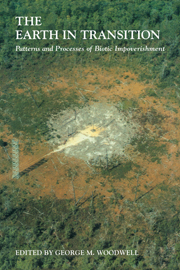Book contents
- Frontmatter
- Contents
- Preface
- Acknowledgments
- List of Contributors
- Part I Global Change and the Patterns of Impoverishment
- Part II Chronic Disturbance and Natural Ecosystems: Forests
- Part III Chronic Disturbance and Natural Ecosystems: Woodlands, Grasslands, and Tundra
- 14 Changes in the Mediterranean Vegetation of Israel in Response to Human Habitation and Land Use
- 15 Bromus tectorum, a Biotic Cause of Ecosystem Impoverishment in the Great Basin
- 16 Detecting Early Signs of Regional Air-Pollution Injury to Coastal Sage Scrub
- 17 Arctic Ecosystems: Patterns of Change in Response to Disturbance
- Part IV Chronic Disturbance and Natural Ecosystems: Aquatic and Emergent Ecosystems
- Part V Conclusion: Steps toward a World That Runs Itself
- Name Index
- Subject Index
14 - Changes in the Mediterranean Vegetation of Israel in Response to Human Habitation and Land Use
Published online by Cambridge University Press: 24 November 2009
- Frontmatter
- Contents
- Preface
- Acknowledgments
- List of Contributors
- Part I Global Change and the Patterns of Impoverishment
- Part II Chronic Disturbance and Natural Ecosystems: Forests
- Part III Chronic Disturbance and Natural Ecosystems: Woodlands, Grasslands, and Tundra
- 14 Changes in the Mediterranean Vegetation of Israel in Response to Human Habitation and Land Use
- 15 Bromus tectorum, a Biotic Cause of Ecosystem Impoverishment in the Great Basin
- 16 Detecting Early Signs of Regional Air-Pollution Injury to Coastal Sage Scrub
- 17 Arctic Ecosystems: Patterns of Change in Response to Disturbance
- Part IV Chronic Disturbance and Natural Ecosystems: Aquatic and Emergent Ecosystems
- Part V Conclusion: Steps toward a World That Runs Itself
- Name Index
- Subject Index
Summary
Editor's Note: Ecologists normally think of evolution as independent of human influences. But people have been around for at least 2 million years, long enough to have influenced not only the landscape but evolution itself.
Naveh, a landscape ecologist, shows how long habitation of the Mediterranean Basin has affected both species and the structure of the communities of this region. The vegetation of the basin is both unique in having evolved over many thousands of years with dense human populations and, strangely, common to the point of illustrating the central principle of impoverishment.
The story is fascinating but not elevating: the human role has been persistent, unrelieved, continuous pressure toward impoverishment. The evolutionary response has been, not surprisingly, adaptation in the pattern now so familiar in these pages. Where we started on this path is obscure, buried in geological history hundreds of thousands of years back and interpretable in more recent times only from such fragmentary documents as the records of the rain of pollen left in special places such as bogs.
Naveh brings a lifetime of research and intimate knowlege of the region to bear on the history and development of the Mediterranean vegetation.
- Type
- Chapter
- Information
- The Earth in TransitionPatterns and Processes of Biotic Impoverishment, pp. 259 - 300Publisher: Cambridge University PressPrint publication year: 1991
- 8
- Cited by



